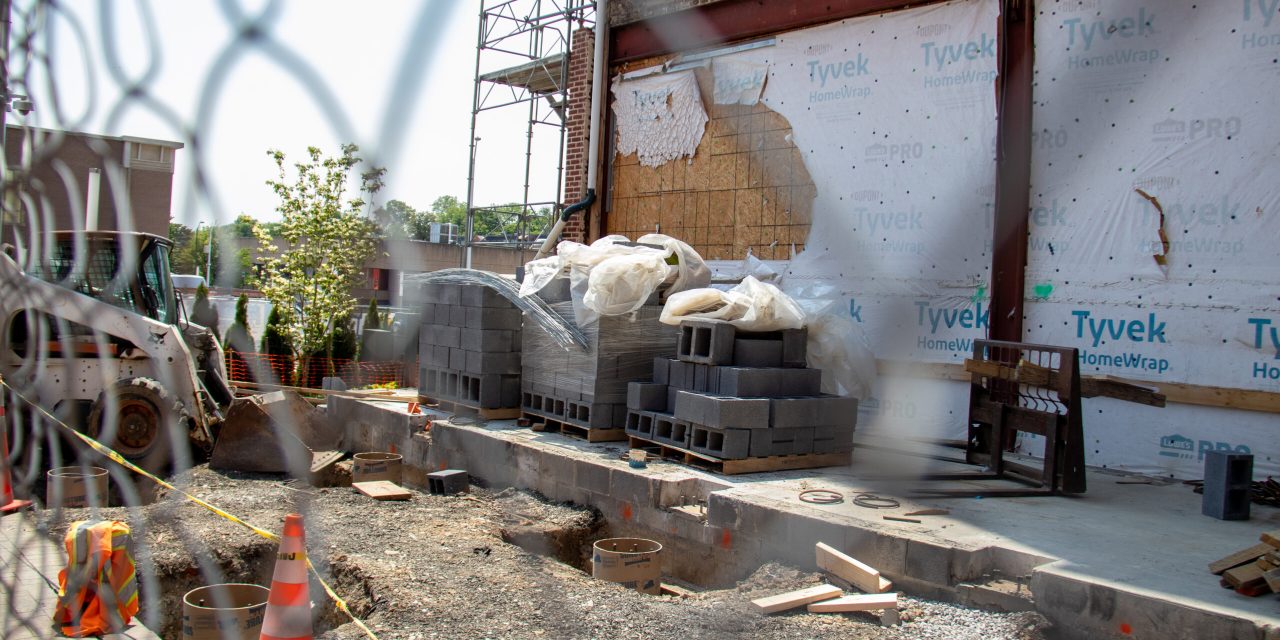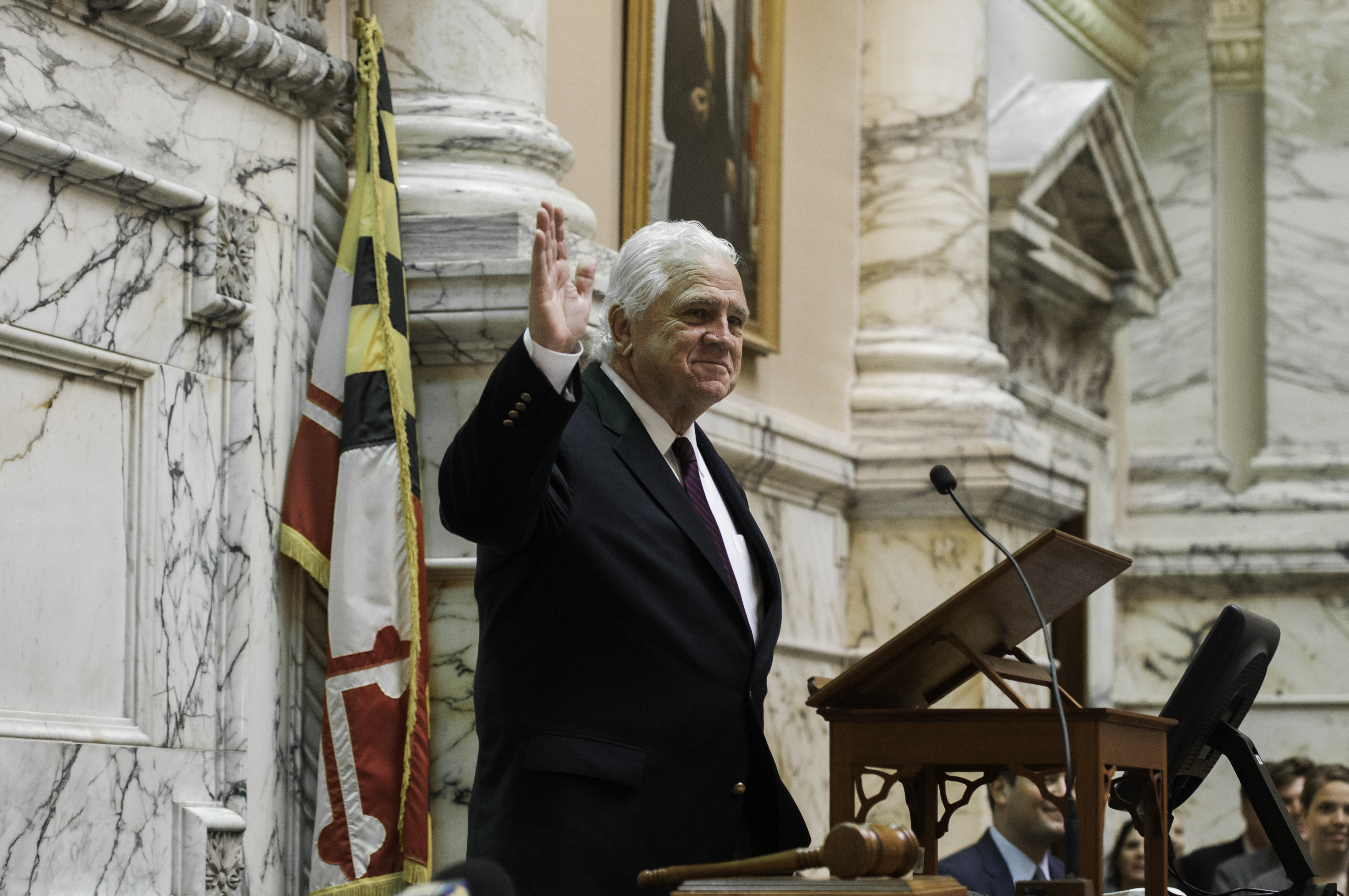By MATT HARADEN, OLIVIA JANIK and KYROS MORALES
HAGERSTOWN – The new ballpark under construction here is the latest effort to bring baseball back to a town that has a rich history tied to the game. But the project is also an attempt to revitalize a city core that has been deteriorating for decades.
The ballpark—a project sought by local leaders for two decades—will serve as the home to a new minor league baseball team that will be a member of the Atlantic League. The stadium will also host other sporting and cultural events.
Ever since the Maryland General Assembly approved funding for the $70 million stadium in 2021, local officials have touted the project as the long-awaited catalyst that will spark Hagerstown’s turnaround.
“We’re looking at ways to reinvent our economy,” Paul Corderman, a Maryland state senator who ran for office with the goal of tapping state funds for his hometown, said.
He added that officials are hopeful that the stadium will “provide a little added…..incentive for individuals to want to invest.” And that, he believes, will bring people back downtown, igniting a renaissance.
But whether the new stadium will transform the city’s downtown into a vibrant city center is far from certain. Interviews with realtors, businesses, and government officials showed a divide in the level of enthusiasm for the stadium. Many economists argue that ballparks rarely generate enough economic activity to turn around an ailing economy, especially in places like downtown Hagerstown where homelessness and drug addiction are pressing problems.
Minor league stadiums “really don’t have a great fiscal impact,” Gary McGuigan, an executive vice president at the Maryland Stadium Authority, said.
However, McGuigan added that there can be significant “speculative development” beyond a ballpark itself. McGuigan pointed to Lancaster and York, Pennsylvania, cities within 125 miles of Hagerstown, where minor-league ballparks recently have been built in or near downtown. In both places, he said, “development has occurred all around and it’s been viewed as a success.”
The stadium authority’s role in the Hagerstown project was to produce economic and cost studies on potential projects, and then issue bonds to finance the projects approved by the state legislature. Once the authority presented its report, the legislature decided on the project’s future based on economic viability or political reasons, McGuigan said. The state’s history of funding minor league stadiums and Corderman’s advocacy are what ultimately led to the legislature approving the project, he said.
“We were all actually surprised when they got funded,” McGuigan said. “It’s like an amazing feat and hats off to the local senator who advocated for it.”
Unlike convention centers, which bring visitors from out of town who spend money on hotels and restaurants for several days, minor league stadiums attract locals who attend games that last a few hours. Stadiums don’t increase spending in towns; they simply “move it around,” sports economist Dennis Coates said. New stadiums don’t increase people’s spending on entertainment, so if they attend a baseball game, they’re not spending their money at a local restaurant or movie theater. Coates added that because the new Hagerstown team will be unaffiliated with a Major League Baseball team, it may not have the advantage of a star player on a rehab assignment or an up-and-coming prospect to draw crowds.
Yet as stadium construction proceeds—the ballpark is expected to be completed in the fall of 2024 — t,here are signs that the Hagerstown metropolitan area is already starting to see an economic uptick. While the trigger for the growth is partly related to the return of baseball, other trends may be playing a bigger role, including the rise of e-commerce, low real estate costs an,d the growing popularity of a nearby interstate highway.
“I think that the Covid pandemic and its focus on industrial development, e-commerce provided us the leverage to draw the attention (from investors) that we’ve been dying to have,” said Jonathan Horowitz, director of business development in Washington County, which includes Hagerstown. While he’s optimistic about the prospects for the county overall, he’s not sure about the city’s downtown.
Hagerstown, a city of 43,000 people, is located in northwestern Maryland near the borders of Pennsylvania and West Virginia. The city was once one of the state’s largest due to its development as a transportation hub. Multiple freight and passenger railroad lines run through the city. However, when passenger service was halted and factories closed or reduced staff, Hagerstown’s economy started to contract.
Today, Hagerstown is among the poorest cities in Maryland with a poverty rate of 25.5%, more than double the statewide average of 10.3% and the nationwide average of 11.6%, according to U.S. Census Bureau data. The median household income in Hagerstown was $42,965 in 2021 compared to $91,431 for the state overall.
“I understand that we might not be as economically fruitful out here as some of the others are, but we have a lot to offer out here and I think they’ll see it as a good economic opportunity out here,” said Scott Nicewarner, Hagerstown’s city administrator.
Indeed, businesses started giving the Hagerstown area a second look during the pandemic, a year before the state approved funding for the stadium. As more Americans started shopping online, retailers such as Amazon needed additional warehouse space near their customers and along major highways. In the mid-Atlantic region, the Hagerstown area became an increasingly popular location, due to the low cost of real estate but also to its proximity to Interstate Highway 81, which some logistics and transportation companies were starting to favor over the more crowded Interstate Highway 95.
“We experienced a wave of land purchase that I’ve never seen anywhere in my career,” said Horowitz, who estimates that land prices jumped from about $70,000 an acre a few years ago to about $150,000 an acre.
Doug Reaser, Hagerstown’s economic development manager, estimates that warehouse and industrial companies will bring in about 7,500 jobs and about $1.2 billion in total investments between 2019-2024.
The residential real estate market is also improving. According to real estate brokerage Redfin, the median sale price for a single-family house in Hagerstown was $265,500 in March. While that is about 66% higher than it was in March 2018, it’s still significantly lower than the state average of $378,900. And homes are selling faster. Since March 2018, the median number of days a house stays on the market has fallen from 83 to 37 days.
The rising demand, according to real estate brokers, is led by families and individuals looking for affordable housing and strong schools. Many are relocating from Washington and Baltimore metro areas, where the cost of living is higher. Hagerstown “is very commuter-friendly and taxes are lower in Washington County,” said Debra Moser, a real estate agent for RE/MAX. “But it’s still within commuting distance,” to Washington and Baltimore.
Shirley Bayer, a real estate agent for RE/MAX, said more out-of-towners are showing up at open houses. “Usually around 15 people is a good turnout for an open house, and that’s higher than it used to be,” Bayer said. “The main attraction for moving here is cheaper prices and lower taxes.”
Meanwhile, some businesses are starting to tiptoe into the troubled downtown area. Hub City Brewery, a new 22,000-square-foot brewery, and taproom, is under construction and expected to open in late 2023 or early 2024.
When Hub City Brewery owner David Blackmon ventured into Hagerstown, he originally wanted to use the space for production.
“I was introduced to the building by city employees and it was a perfect fit for production, but it is so large and in a central downtown location it just made sense to open another taproom as well,” Blackmon said.
Blackmon currently owns two other breweries in Maryland and believes that the new Hagerstown location has the potential to grow larger than both.
“I see a lot of amazing things happening in Hagerstown. The growth is crazy at the moment.”
Hub City Brewery is not the only restaurant expansion in the area. According to Blackmon, there will be a new strip of stores and restaurants, including two additional new breweries.
“Ultimately it’s not as much about baseball as it is the experience. If you offer a good entertainment opportunity for all ages, I think that’s where the interest will be,” Nicewarner said.
In expectation of increased traffic, Hagerstown’s Museum of Fine Arts is expanding. The museum expects to pull visitors not just from Hagerstown but from the region as well.
“Within a 60-minute drive, putting the museum in the center, going 60 minutes in any direction, there’s about 1.5 million people,” said Roger Fairbourn, former president of the museum’s board and owner of Roger Fairbourn Real Estate.
The project will provide more space for art classes, youth programs, and more.
The Maryland Theatre, another historic Hagerstown attraction, just built a five-level Performing Arts Center, which can hold larger gatherings and support bigger events at the facility, according to its website.
“It’s doing great things that are going to become very popular resources in the community,” Fairbourn said of these expansions.
Apartment developers, meanwhile, are vying for space. Dan Spedden, President of the Hagerstown/Washington County Convention and Visitors Bureau, estimates that five residential projects are under construction in the downtown area. He said around $80 million was invested in private investments towards these projects.
“All of this is because of the stadium,” Spedden said.
Still, there are lingering concerns about the long-term success of the new stadium, considering its location. Horowitz worries that the presence of “vagrants and panhandlers” who frequent downtown to receive social services creates a potentially unwelcoming environment that might deter people from visiting the area. But Horowitz remains hopeful.
“I have my fingers crossed, and I pray and hope that the stadium is the catalyst that does create the revitalization of our downtown.”





Recent Comments